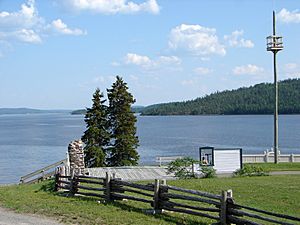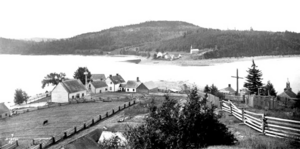Fort Témiscamingue facts for kids
Quick facts for kids Fort Témiscamingue |
|
|---|---|
| Ville-Marie | |

Remnants of Fort Témiscamingue with Lake Timiskaming in the background.
|
|
| Type | Fort |
| Site information | |
| Controlled by | New France; Canada |
| Official name: Fort Témiscamingue National Historic Site of Canada | |
| Designated: | 1931 |
| Site history | |
| Built | 1679 |
| In use | 1679–1902 |
Fort Témiscamingue was an important trading post in Canada. It was built in the 1700s in Duhamel-Ouest, Quebec, close to Ville-Marie. This fort was on the east side of Lake Timiskaming. It was a key stop on the fur trade route. Today, Fort Témiscamingue is a National Historic Site. Parks Canada manages it with the Timiskaming First Nation.
Contents
The History of Fort Témiscamingue
Lake Timiskaming was a perfect spot for a trading post. It sits at a bend in the Ottawa River. This lake was also on a major canoe route. This route connected Hudson Bay to the Saint Lawrence River. It was about halfway through a long, forty-day journey. The first Europeans to use this route were part of the Hudson Bay expedition (1686).
Early Trading Posts and Conflicts
Around 1679, merchants from Montreal built a fort. It was on the west side of Lake Timiskaming. They wanted to compete with English trading posts. But the Iroquois people destroyed this fort in 1688.
In 1720, French merchants built a new Fort Témiscamingue. This time, it was on the east side of "The Narrows." This is where the lake shores are very close. This spot was once an Algonquin camp. They called it "Obadjiwan Point," meaning "the strait where the current flows."
Changes Over Time
After New France fell, other traders took over the post. The North West Company used it starting in 1788. Then the Hudson's Bay Company took over in 1821. At first, supplies came from Moose Factory. Later, after 1863, they came from Montreal. This was because travel became easier.
As time passed, the area changed. Lumberjacks arrived, and then railroads and steamboats. The trading post slowly became a general store. In 1887, the main store moved to Ville-Marie, Quebec. The fort finally closed its doors in 1902. Today, you can visit the historic site.
The Mission at Fort Témiscamingue
A Roman Catholic mission was also at Fort Témiscamingue. It was on the eastern shore of Lake Timiskaming. In 1863, the mission moved to the Ontario side of the lake. It included a house for priests, a small hospital, and a church.
Fort Témiscamingue: A National Historic Site
Fort Témiscamingue became a national historic site in 1931. It is special for both its history and its nature. The park has three main natural areas. These are the plateau, the steep hills (escarpments), and the lowlands.
Nature and the Enchanted Forest
Most of the park is a wooded area. It has about 20 different types of trees. Many plants here are typical of the Laurentian maple and St. Lawrence forests. One special part is a forest of cedar trees. Their trunks are so twisted that people call it the "Enchanted Forest."
Visiting the Site Today
Not much of the original fort remains. But there is a modern visitor's center. It has exhibits and shows that bring the fort's history to life. You can learn all about the people who lived and worked there.
See also



